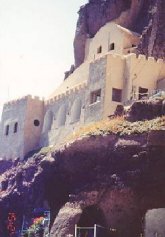| SANTORINI -- CALLISTE
According to tradition, the Island was first called Kalliste, meaning
"the best". (Kalliste is the female for the
best, while kallistos is the male. Greeks usually give female
names to islands).
By that time the island was inhabited by Phoenicians. Kadmos the
son of Agenor, stopped at Kalliste during one of his wanderings in
search of Europe. He left behind a group of Phoenicians who were accompanying
him and among them was his kinsman Membliaros. These Phoenicians occupied
the island until the arrival of Theras.
Thira (or Thera)
In antiquity the island's name was Thera. According to tradition,
the island was named after Theras, son of Autesion, who was the
descendant of Polyneikes. Theras, having brought with him a band of
Mycaenians from Sparta, made the island a colony of the Lacedaemonians.
Before Theras, the island was occupied by Phoenicians and it was called
"Kalliste".
(Although the island was named after Theras, the name Thera -- without
the final "s" -- is a female name which is usual for most
of the Hellenic islands.)
Strogili
Another ancient name referring to Santorini was Strogili.
Strogili means the "rounded". This name was given
because of the round shape of the group of islands which form Santorini.
Santorini
The name Santorini is much more recent and is the name that Hellenes
(Greeks) use nowadays for this group of islands. Nevertheless the name
"Thera" is also used.
The name Santorini, which has a Latin root, was given by the Venetians
who, after the Fourth Crusade (1204), had dominion over the islands.
The origin of the name was the Chapel of Aghia Irini (Santa Irini
- Santorini) which was built on Therasia.
The Chapel was situated on a small bay where the Venetians moored
their boats.
by Thomas J. Pagonis
Copyright: Hellenic Electronic Center
Photos: Ian Swindale and others
|





|




